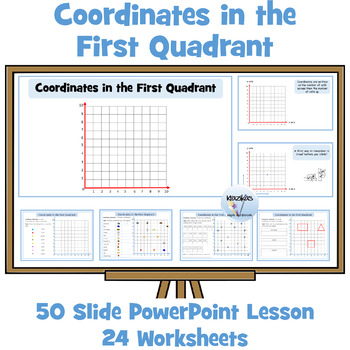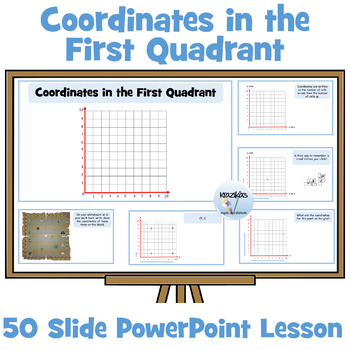Coordinates in the First Quadrant
Inspire and Educate
1.2k Followers
Resource Type
Standards
CCSS5.G.A.1
CCSS5.G.A.2
Formats Included
- Zip
Pages
74 pages
Inspire and Educate
1.2k Followers
Products in this Bundle (2)
Description
This bundle contains a PowerPoint lesson and a set of differentiated worksheets on coordinates in the first quadrant.
PowerPoint Lesson
This is a highly visual and interactive 50-slide PowerPoint lesson on coordinates in the first quadrant. The PowerPoint clearly explains and visually demonstrates the following:
- grids
- x and y axes
- the origin
- how to locate coordinates
- how to plot coordinates
- how to write coordinates
Opportunities are provided within the PowerPoint for students to locate and plot coordinates.
Coordinates in the First Quadrant Differentiated Worksheets
This resource contains a 24 page workbook / 24 differentiated worksheets on coordinates in the first quadrant. Answers are provided.
Tasks include:
- locating coordinates
- plotting coordinates
- finding missing coordinates
Keep informed of free and new resources by following me here.
Total Pages
74 pages
Answer Key
Included
Teaching Duration
N/A
Report this resource to TPT
Reported resources will be reviewed by our team. Report this resource to let us know if this resource violates TPT’s content guidelines.
Standards
to see state-specific standards (only available in the US).
CCSS5.G.A.1
Use a pair of perpendicular number lines, called axes, to define a coordinate system, with the intersection of the lines (the origin) arranged to coincide with the 0 on each line and a given point in the plane located by using an ordered pair of numbers, called its coordinates. Understand that the first number indicates how far to travel from the origin in the direction of one axis, and the second number indicates how far to travel in the direction of the second axis, with the convention that the names of the two axes and the coordinates correspond (e.g., 𝘹-axis and 𝘹-coordinate, 𝘺-axis and 𝘺-coordinate).
CCSS5.G.A.2
Represent real world and mathematical problems by graphing points in the first quadrant of the coordinate plane, and interpret coordinate values of points in the context of the situation.





